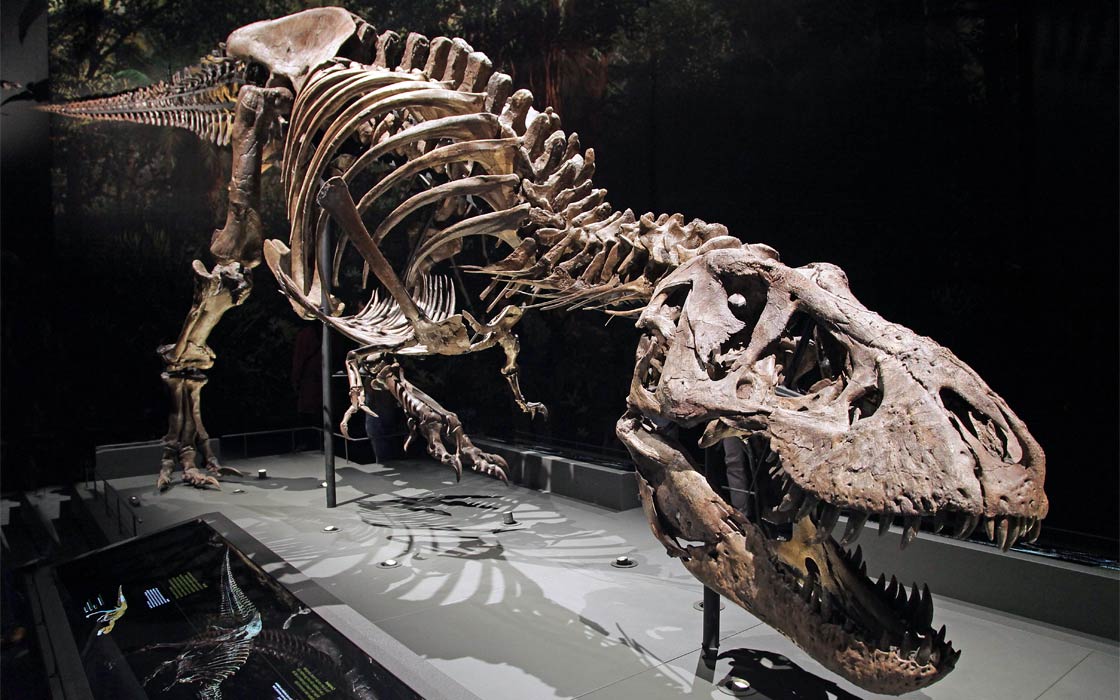Every month, 100,000 readers use the Dinosaur Database, but we receive no support from you. Developing and updating the database requires a lot of work. If you want it to remain open and be updated, please support us via the "Buy us a coffee" button available on every page or via the Support page.
Dinosaur: Tyrannosaurus mcraeensis

| Length*: | 11.9 m | 39.0 ft |
| Weight*: | 8.2 t | 18,078 lb |
Period
Epoch: Late Cretaceous
Stage: Latest Campanian-Early Maastrichtian
Years: 83.6–66 Ma
Details
Status: valid
Author: Dalman et al.
Year: 2024
Distribution
Area: North America
Country: USA
Region: New Mexico
Formation: Hall Lake
Description
Tyrannosaurus mcraeensis
Tyrannosaurus mcraeensis was a giant tyrannosaurid that lived in what is now New Mexico during the Late Cretaceous period, around 72.7 to 66 Ma million years ago. It is one of the oldest known giant members of Tyrannosaurini, the same group that includes Tyrannosaurus rex. The species name mcraeensis refers to the McRae Formation, where its fossils were found.
For years, its remains were thought to belong to Tyrannosaurus rex, but recent studies show that T. mcraeensis had distinct features, suggesting it was an earlier, separate species. This discovery sheds light on the evolution of giant tyrannosaurs, showing that they reached massive sizes earlier than previously believed.
Physical Characteristics
Tyrannosaurus mcraeensis was a huge theropod, similar in size to T. rex. It is estimated to have reached 12 meters (39 feet) in length and weighed between 8,000 and 9,000 kg (17,600–19,800 lb). Like its famous cousin, T. mcraeensis had a powerful build, a massive head, and strong hind legs, making it one of the dominant predators of its time.
Some of its unique features include:
- A lower, more forward-positioned bony ridge above the eye, different from T. rex.
- A shallower, upturned lower jaw, suggesting differences in how it bit into prey.
- Differences in the shape of skull bones, particularly in the squamosal and postorbital regions, which affect the shape of the eye socket and skull profile.
Despite these differences, T. mcraeensis shared the classic tyrannosaur body plan—large head, short but strong arms, powerful legs, and a long tail for balance.
Diet and Feeding Habits
As an apex predator, Tyrannosaurus mcraeensis was at the top of the food chain. It likely preyed on large herbivores such as:
- Ceratopsians, like Sierraceratops, which lived in the same region.
- Hadrosaurids, the duck-billed dinosaurs common in Late Cretaceous ecosystems.
- Titanosaurs, possibly cf. Alamosaurus, though these may have been too large for all but the biggest T. mcraeensis individuals.
Like T. rex, it had robust, serrated teeth designed for crushing bone and tearing through flesh. Its strong bite force and reinforced skull structure suggest it was capable of delivering devastating bites to its prey. It may have also scavenged when the opportunity arose, as many large carnivores do.
Habitat and Distribution
Tyrannosaurus mcraeensis lived in what is now southern Laramidia, specifically in present-day New Mexico. Fossils have been found in the Hall Lake Member of the McRae Formation, which was a warm, subtropical environment with river systems and floodplains. The ecosystem was home to a variety of dinosaurs, including:
- Other large herbivores, such as Sierraceratops turneri.
- Smaller theropods, which likely filled different predatory niches.
- Crocodyliforms, turtles, and pterosaurs, making for a diverse prehistoric landscape.
The discovery of T. mcraeensis suggests that giant tyrannosaurs may have evolved in southern North America before spreading northward.
Behavior and Social Structure
While direct evidence of its behavior is lacking, Tyrannosaurus mcraeensis likely behaved similarly to other large tyrannosaurs:
- It may have been a solitary hunter, using its size and strength to take down prey on its own.
- It could have engaged in intraspecific combat, as seen in T. rex, where bite marks on skulls suggest fights between individuals.
- It might have had a strong sense of smell, useful for detecting prey or scavenging opportunities from long distances.
Discovery and Research
The first fossils of Tyrannosaurus mcraeensis were discovered in the Hall Lake Member of the McRae Formation in New Mexico. The holotype specimen, NMMNH P-3698, includes:
- Parts of the skull, including the right postorbital and squamosal.
- Fragments of the upper and lower jaw.
- Several isolated teeth and postcranial elements.
Originally, this specimen was thought to belong to Tyrannosaurus rex, but a 2024 study by Sebastian Dalman, Mark Loewen, and colleagues identified enough differences to classify it as a distinct species. This discovery helps fill gaps in the fossil record, showing that large tyrannosaurs were present in North America earlier than previously thought.
Significance and Interesting Facts
- Sheds light on the origins of Tyrannosaurus rex, suggesting that giant tyrannosaurins may have evolved in southern North America before expanding northward.
- Coexisted with unique dinosaurs, including the newly described ceratopsian Sierraceratops from the same formation.
- One of the largest known tyrannosaurs of its time, reaching lengths comparable to T. rex.
- Provides evidence of regional diversity among late Cretaceous tyrannosaurs, showing that different species may have dominated different parts of Laramidia.
Tyrannosaurus mcraeensis vs. Tyrannosaurus rex
Tyrannosaurus mcraeensis and Tyrannosaurus rex were both enormous, apex predators that lived during the Late Cretaceous, but recent findings suggest they were much closer in time than previously thought. Instead of T. mcraeensis being a direct ancestor of T. rex, it may represent a southern population of Tyrannosaurus, adapted to different environments.
Similarities
- Size and Build
- Both species were among the largest land predators in history.
- T. mcraeensis and T. rex had powerful legs, massive skulls, and strong tails for balance.
- Estimated lengths: Around 12 meters (39 feet) for both species.
- Weight: Between 8,000 and 9,000 kg (17,600–19,800 lbs), similar for both.
- Bite Force and Teeth
- Both had thick, serrated teeth designed for crushing bone.
- Their teeth were banana-shaped, perfect for gripping struggling prey.
- T. rex may have had a slightly stronger bite force, but T. mcraeensis was still a bone-crushing predator.
- Powerful Hindlimbs
- Both species had strong, muscular legs, allowing them to chase down prey over short distances.
- They were likely ambush predators, relying on bursts of speed rather than endurance.
- Forelimbs
- Both had short but muscular arms, though their exact function is still debated.
- Sensory Adaptations
- Both species had large olfactory bulbs, suggesting an excellent sense of smell for tracking prey or detecting carrion.
- Binocular vision was well-developed in both, giving them depth perception for precise attacks.
Key Differences
| Feature | Tyrannosaurus mcraeensis | Tyrannosaurus rex |
| Time Period | 69–66 million years ago (Late Maastrichtian) | 68–66 million years ago (Late Maastrichtian) |
| Location | Southern Laramidia (New Mexico) | Widespread across North America |
| Skull Shape | Shallower, more upturned lower jaw | Deeper, more robust skull |
| Eye Ridge | Lower, more forward-positioned bony ridge above the eye | More pronounced, higher-positioned ridge |
| Dentary (Lower Jaw) | Shallower, slightly upturned | Deeper and downturned |
| Postorbital Bone | Different shape, affecting eye socket structure | More rounded postorbital |
| Bite Strength | Likely strong, but may not have reached T. rex levels | One of the strongest bite forces of any land animal |
| Evolutionary Status | Possible southern regional variation of T. rex | Most derived (advanced) species of Tyrannosaurini |
What Does This Mean?
- With new dating evidence placing T. mcraeensis between 69 and 66 million years ago, it no longer represents a much earlier stage in tyrannosaur evolution.
- Instead, it may be a regional variation of Tyrannosaurus rex, living in southern Laramidia (New Mexico) while T. rex dominated the northern regions.
- If further studies confirm their close relationship, T. mcraeensis might eventually be reclassified as a subspecies or even just a local population of T. rex, rather than a distinct species.
Conclusion
Tyrannosaurus mcraeensis and Tyrannosaurus rex were very similar in size, diet, and hunting strategy, but had subtle skull differences. The new dating evidence suggests they were contemporaries, meaning T. mcraeensis might not be an early giant tyrannosaur, but rather a southern adaptation of Tyrannosaurus rex. Further research will determine whether it remains a distinct species or gets absorbed into T. rex as a regional variant.
Locations
Sources
Material: Partial skull and lower jaws.
References: Dalman et al. (2024). "A giant tyrannosaur from the Campanian–Maastrichtian of southern North America and the evolution of tyrannosaurid gigantism".




